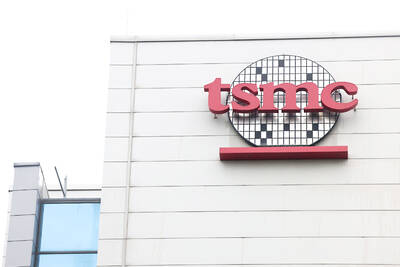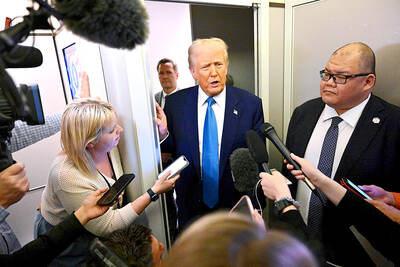The number of workers on unpaid leave at Hsinchu Science Park has dropped by nearly 60 percent to 40,933 from a high of about 100,000, because of increasing orders and rising capacity utilization rates, administrators said on Sunday.
Miin Wu (吳敏求), chairman of chipmaker science park based Macronix International Co (旺宏電子), told President Ma Ying-jeou (馬英九) during a visit on Sunday that the firm had begun to reverse its policy of unpaid leave last month and even planned to hire another 150 engineers — 50 for the research and development department and 100 for the manufacturing department.
Macronix president Lu Chih-yuan (盧志遠) said the company’s factory usage was rising fast and may reach full utilization next month.
However, as customers are conservative about placing orders amid the economic downturn, most orders were short-term rush orders, Lu said.
As the outlook for the third quarter was unclear, Macronix would not invest in a 12-inch plant until the third quarter, when the prospects may become better, Lu said.
Yen Tzong-ming (顏宗明), director-general of the Hsinchu Science Park Administration, said many statistical indicators showed significant improvement.
Output value in the science park, for example, reached only NT$91.4 billion (US$2.75 billion) in the first two months of this year but the figure was expected to rise to a combined NT$118.8 billion for March and last month, Yen said.
The number of unemployed workers at the science park had declined month by month this year, Yen said. Some 382 people lost their jobs last month, from 1,956 last December, he said.
Yen said many firms located in the science park were forced to implement unpaid leave, after seeing their capacity utilization rate fall to between 30 percent and 40 percent amid falling orders.
As a result, the number of workers on unpaid leave surged to 14,500 in January from 870 in December, Yen said.
Since last month, firms in the park said they had seen a recovery in new orders received, prompting most of the firms there to increase their capacity utilization to between 70 percent and 80 percent, Yen said.
As of Friday, 813 businesses in Taiwan have asked employees to take unpaid leave, Council of Labor Affairs statistics show.
The figure represented the lowest number since the council began to notify the government of the number of workers on unpaid leave in mid-January.
The number reached a peak of 238,975 on March 3.
“The jobless situation is stabilizing for the time being, with local firms receiving short-term rush orders from the inventory restocking process,” HSBC analyst Christopher Wong wrote in a note.
“We expect the unemployment rate, to be released this Friday, to rise marginally to 5.8 percent,” Wong said.

When an apartment comes up for rent in Germany’s big cities, hundreds of prospective tenants often queue down the street to view it, but the acute shortage of affordable housing is getting scant attention ahead of today’s snap general election. “Housing is one of the main problems for people, but nobody talks about it, nobody takes it seriously,” said Andreas Ibel, president of Build Europe, an association representing housing developers. Migration and the sluggish economy top the list of voters’ concerns, but analysts say housing policy fails to break through as returns on investment take time to register, making the

‘SILVER LINING’: Although the news caused TSMC to fall on the local market, an analyst said that as tariffs are not set to go into effect until April, there is still time for negotiations US President Donald Trump on Tuesday said that he would likely impose tariffs on semiconductor, automobile and pharmaceutical imports of about 25 percent, with an announcement coming as soon as April 2 in a move that would represent a dramatic widening of the US leader’s trade war. “I probably will tell you that on April 2, but it’ll be in the neighborhood of 25 percent,” Trump told reporters at his Mar-a-Lago club when asked about his plan for auto tariffs. Asked about similar levies on pharmaceutical drugs and semiconductors, the president said that “it’ll be 25 percent and higher, and it’ll

NOT TO WORRY: Some people are concerned funds might continue moving out of the country, but the central bank said financial account outflows are not unusual in Taiwan Taiwan’s outbound investments hit a new high last year due to investments made by contract chipmaker Taiwan Semiconductor Manufacturing Co (TSMC, 台積電) and other major manufacturers to boost global expansion, the central bank said on Thursday. The net increase in outbound investments last year reached a record US$21.05 billion, while the net increase in outbound investments by Taiwanese residents reached a record US$31.98 billion, central bank data showed. Chen Fei-wen (陳斐紋), deputy director of the central bank’s Department of Economic Research, said the increase was largely due to TSMC’s efforts to expand production in the US and Japan. Investments by Vanguard International

WARNING SHOT: The US president has threatened to impose 25 percent tariffs on all imported vehicles, and similar or higher duties on pharmaceuticals and semiconductors US President Donald Trump on Wednesday suggested that a trade deal with China was “possible” — a key target in the US leader’s tariffs policy. The US in 2020 had already agreed to “a great trade deal with China” and a new deal was “possible,” Trump said. Trump said he expected Chinese President Xi Jinping (習近平) to visit the US, without giving a timeline for his trip. Trump also said that he was talking to China about TikTok, as the US seeks to broker a sale of the popular app owned by Chinese firm ByteDance Ltd (字節跳動). Trump last week said that he had